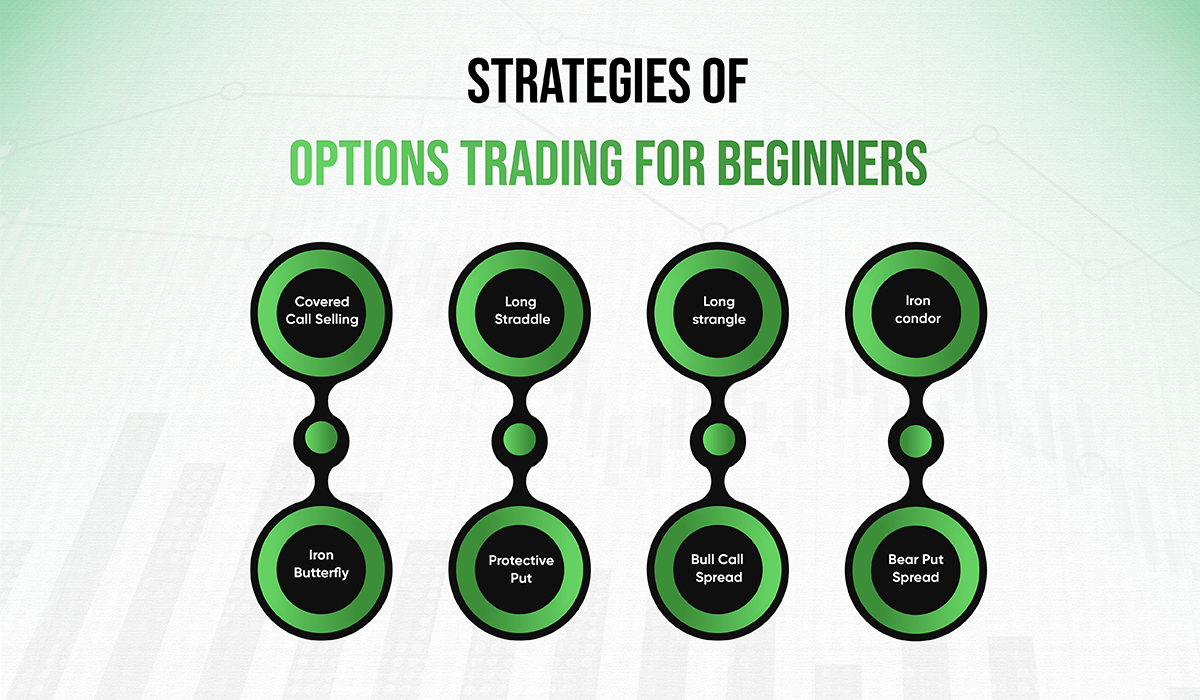Options Trading for Beginners: A Comprehensive Guide


Options trading gives a fascinating and open door to novices to enter the world of financial business sectors and possibly benefit from cost outcomes without really possessing the basic resources. Investors can profit from this adaptable and potential financial instrument in both bullish and bearish markets. This blog will help you understand the concept of option trading if you are new to it.
Options trading for beginners is a type of derivative market in which traders can buy or sell options contracts. Traders can use these contracts to buy or sell an underlying asset at a predetermined price, known as the strike price, within a predetermined time frame, known as the expiration date. However, they are not required to do so.
Table of Contents
ToggleHow do options trading for beginners work?
The purchase or sale of options contracts is part of options trading. A predetermined number of shares of an underlying asset, such as stocks, commodities, or indices, are represented by these contracts. By correctly predicting the direction of the underlying asset’s price movement, traders can profit from options.
There are a variety of options trading strategies, each with its risk-reward profile and goal. Long calls and long puts Traders can profit from a rising asset price with a long call option, while they can profit from a falling asset price with a long put option. Leveraged exposure to price changes is provided by these strategies.
Advantages of options trading for beginners
- Leverage options let traders control a large number of underlying assets with a small premium investment. options trading for beginners is an appealing strategy for investors looking for higher returns because this leverage amplifies both potential gains and losses.
- Hedging is the process used in options to offset potential losses in other positions. Protective puts and collar strategies can be used by traders to reduce downside risk and provide protection against price fluctuations.
- Although options tradings carry risk systematic risk management strategies can help you minimize the losses Traders have a predetermined risk-to-reward ratio because the maximum loss is limited to the premium paid for the options contract.
How Options Trading Works for Beginners
There are several ways to trade options:
- Buying Call Options: Traders can make money by purchasing call options if the price of the underlying asset rises above the strike price before the option’s expiration date. Traders can use this strategy to take part in price rises while only taking on the premium they pay.
- Buying Put Options: Traders seek to profit from price declines by purchasing put options. Put options gain value if the price of the underlying asset falls below the strike price before the expiration date.
- Selling Call Options: When you sell call options, you give another person the right to buy the underlying asset from you at a certain price within a certain amount of time. You receive the premium in consideration for this obligation. If the price of the underlying asset stays below the strike price until the contract expires, this strategy will make money.
- Selling Put Options: When you sell put options, you give another person the right to sell the underlying asset to you at a certain price within a certain amount of time. You get the premium in return. If the price of the underlying asset remains above the strike price until the contract expires, this strategy will result in profits.
Risk Management in Options Trading for Beginners
To safeguard your capital and reduce losses, effective risk management is essential in options trading. Some essential methods are as follows:
- Setting Stop-Loss Orders By automatically closing out a position when the price reaches a predetermined level, stop-loss orders can help limit losses.
- Risk can be reduced By diversifying your options( hedging) trades across various calls and puts. Any single trade or market event will have less of an effect on you if you spread out your investments.
- Position Sizing To effectively manage risk, it is essential to carefully determine the appropriate position size based on your risk tolerance and account balance. With the right position size, you won’t put too much money at risk in a single trade.
Options Trading Strategies

There is a wide range of options trading strategies that can be used to achieve various trading goals. Some of the most popular include:
Covered Call Selling
Call options against assets you already own is the covered call strategy. It allows you to profit from the stability or slight price increase of the underlying asset while also generating income from the premium received.
Long Straddle
In a long straddle, you buy both a call and a put option with the same strike price and expiration date at the same time. Regardless of whether the market goes up or down, this strategy makes money when prices go up or down a lot
Long strangle
The neutral strategy known as the Long Strangle (also known as the Buy Strangle or Option Strangle) involves simultaneously purchasing Slightly OTM Put Options and Slightly OTM Call Options with the same underlying asset and expiration date. When the trader anticipates high volatility in the underlying stock shortly, this long-strangle strategy may be utilized. It’s a method with a lot of potential for reward and little risk.
Iron condor
An options strategy known as an iron condor has four strike prices: two calls (one long and one short), two puts (one long and one short), and all of them have the same expiration date. The iron condor makes the most money when the underlying asset closes at expiration between the intermediate strike prices.
Iron Butterfly
The Iron Butterfly is a method for trading options that uses four different contracts to try to make money from the movement of futures and/or options that work within a certain range. Predicting a region at a time when the value of options is anticipated to be on the decline is the key to success with this strategy, which is intended to take advantage of a decrease in implied volatility.
Protective Put
Buying put options on an existing stock position to safeguard against potential downside risks is the protective put strategy. The gains will be compensated for by the put options if the stock price falls.
Bull Call Spread
Buying call options at a lower strike price and selling them at a higher strike price at the same time is a bull call spread. When a moderate price rise is anticipated, this strategy is used.
Bear Put Spread
Buying put options at a higher strike price and selling put options at a lower strike price at the same time is a bear put spread. When a moderate price decline is anticipated, this strategy is used.
More strategies are used in options trading for beginners apart from the above-mentioned ones.
Also Read: Bullish Options Strategies
Common Mistakes to Avoid When Trading Options for Beginners
- Options trading for beginners can be complicated, so it’s important to spend time learning the basics.
- To make informed trading decisions, educate yourself on options strategies, risk management methods, and market analysis.
- Consistent success in options trading for beginners necessitates a clearly defined trading plan.
- Your objectives, tolerance for risk, entry and exit strategies, and position sizing guidelines should be outlined in your plan.
- Emotional decision-making and excessive trading Frequent trading without a clear strategy can increase market volatility exposure and incur excessive transaction costs.
- Poor trading outcomes can also result from emotional decision-making motivated by greed or fear.
Conclusion
Options trading for beginners presents an exciting opportunity to investigate the financial markets. You can increase your chances of success in this dynamic trading arena by having a solid understanding of the fundamentals, practicing effective risk management strategies, and continuously learning new things. Keep in mind to start small, diversify your trades, and create a clear trading strategy. options trading for beginners has the potential to become a valuable addition to your investment portfolio with practice and determination.
FAQs
Q1. Are stocks less risky than options?
When compared to stock trading, options trading for beginners is more complicated and carries more risks. However, options can be used to effectively manage risk with the right knowledge, risk management, and strategy implementation.
Q2. Are options trading for beginners?
options trading for beginners can be complicated, but beginners can participate with the right education and risk management. It is recommended to begin with a solid understanding of the fundamentals and practice on paper trading platforms.
Q3. Is option trading strategies profitable for novice traders?
Yes, starting with options trading for beginners can be profitable. It necessitates thorough research, a solid understanding of the market, and disciplined strategy implementation.
Q4. What are my options trading strategies?
Your trading objectives, risk tolerance, and market conditions are just a few of the considerations that go into selecting an options trading strategy. Before putting any options trading strategies into action, it is essential to comprehend their characteristics and potential dangers.
Q5. Where can I find additional resources on options trading strategies?
options trading strategies are covered in detail in a plethora of online resources, including educational websites, books, and courses. Participating in trading communities and interacting with seasoned traders can also yield useful insights.
CATEGORIES



 Facebook
Facebook Instagram
Instagram Youtube
Youtube
